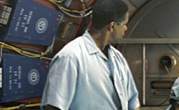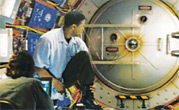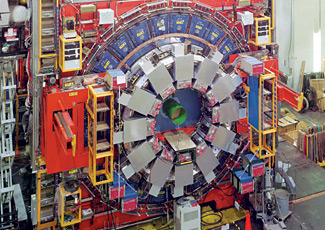Déjà blue
As Clark Cully watched the movie Déjà Vu with his parents, something about the movie’s time machine—with its bright blue wedges of metal spewing a ring of wires—seemed eerily familiar.
As Denzel Washington crawled into the time machine to travel to the past, Cully leaped up and hit pause. “It’s CDF! It’s CDF!” he shouted.
Cully works as a physicist on the CDF experiment at Fermi National Accelerator Laboratory. CDF, a three-story detector painted in classic Fermilab blue, is one of the two large experiments on the Tevatron.
Sure enough, when he enlarged the TV image of the time machine, there was the CDF logo on one of the wedges. “To really make that accurate a reproduction,” Cully says, “you would have had to see the detector or the specs.”
The film crew probably did.
  |
 |
| As Clark Cully watched the movie Déjà Vu, he had his own flash of déjà vu: Something about that time machine seemed oddly familiar. At left, the fictional time machine in scenes from the movie; at right, Fermilab's CDF detector. | |
| Top-left images courtesy of Touchstone Home Entertainment. Top-right photo: Reidar Hahn, Fermilab |
|
Production designer Chris Seager says he first considered medical technology, such as an MRI scanner, as the model for a time machine. But the hardware seemed too small. He visited power plants, NASA’s Jet Propulsion Laboratory, and the Cambridge High Energy Physics Laboratory looking for inspiration. But it was the roundness of particle accelerators, and their raw display of wires and sensors, that finally caught his attention and provided the feeling of evolving science he was seeking.
“We wanted to keep things very much grounded and make it feel like the machine had come from a real laboratory,” Seager says. “We found some fabulous references on the Internet to enormous pieces of equipment,” and incorporated the look of those detectors into the movie prop.
While Cully burst with excitement at seeing the CDF in the movie, his family was more subdued.
After he finished jumping up and down, Cully noticed that his parents and sister looked confused. “They asked me, ‘What’s CDF?’” Cully says, with obvious disappointment. “I guess my family didn’t remember the tour I gave them, or that I’m writing my thesis on it.”
Haley Bridger
Click here to download the pdf version of this article.






